On July 19, the Hendrick House hosted a Farm-to-Table dinner featuring four separate courses, a full crowd, and a clear message: support local food growers while being environmentally friendly.
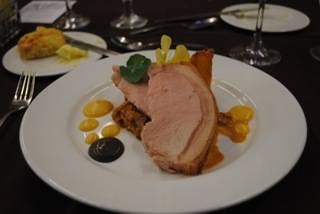 Live piano music and some cocktails kicked things off, and the meal followed at 7:00 p.m. For the starter, the crowd of 40 diners enjoyed a mushroom stew made with a truffle and sherry vinegar sauce. Next came a summer salad of green beans, shaved turnips, kohlrabi rhubarb, cucumber, and goat cheese tossed in a citrus vinaigrette with pepper puree. The entrée was a roasted bone-in pork loin with fried polenta and creamed kimchee topped with grilled Illinois peaches. Local thyme-infused lemon curd with blackberry compote and white chocolate paper was served for desert.
Live piano music and some cocktails kicked things off, and the meal followed at 7:00 p.m. For the starter, the crowd of 40 diners enjoyed a mushroom stew made with a truffle and sherry vinegar sauce. Next came a summer salad of green beans, shaved turnips, kohlrabi rhubarb, cucumber, and goat cheese tossed in a citrus vinaigrette with pepper puree. The entrée was a roasted bone-in pork loin with fried polenta and creamed kimchee topped with grilled Illinois peaches. Local thyme-infused lemon curd with blackberry compote and white chocolate paper was served for desert.
The truly tasty thing about all of this? Every ingredient down to the cilantro and cream was grown locally. Fifteen different farms contributed to the menu, each part of a Community Supported Agriculture (CSA) group. Hendrick House Manager Diane Cooper, 48, wouldn’t have wanted it any other way.
“We heard ‘oohs’ and ‘ahhs’ with each course,” Cooper said. “People were very impressed with the mushroom stew. Some had never tried it before and even claimed to not care for mushrooms, but when they tried it, they loved it.”
What pleased the manager even more than the way the food turned out, was the atmosphere among guests.
“Everyone that came just had a great time,” Cooper said. “There was constant chatter back and forth, questions for our staff, and people left asking when the next dinner would be.”
Hendrick House Food Service Director Sue Dawson, 55, agreed, “It was such a social event. We knew the food would be good, but the whole thing turned into such an opportunity to meet different people from the community. We had all the demographics represented from type of profession to age.”
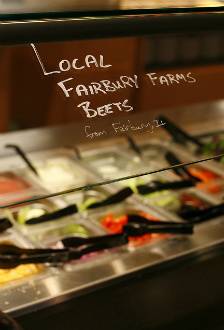 Though a little “different” in appearance maybe, each guest shared the common interest for locally grown food and a respect for the Hendrick House mission.
Though a little “different” in appearance maybe, each guest shared the common interest for locally grown food and a respect for the Hendrick House mission.
“I believe in what we are doing here,” Dawson went on. “I like to eat that way. I like to know where my food is coming from.”
Cooper added, “The drive comes from wanting to support our local economy. I think it’s important to learn about and appreciate the time and effort farmers go through to get food to us.”
This type of mindset has been a part of the management at Hendrick House since its creation in 1948 through Robert and Mary Lee Hendrick. Back then, the establishment was a small house with a student capacity set at 17. Now the capacity sits at 360 with an average of 300 students in residence during the school year.
“Mom and Dad always thought it was important to give students the sense that they were at home,” said CEO and owner Betsy Hendrick. “The local food plays a part in that.”
In 2009, Hendrick and the rest of the staff brought that commitment to another level. The Hendrick House was awarded a Gold Leadership in Energy and Environmental Design Certification by the U.S. Green Building Certification Institute. At the time, Hendrick House was the only establishment with such an honor, which had been given based on the eco-friendly design of a new dining hall and kitchen.
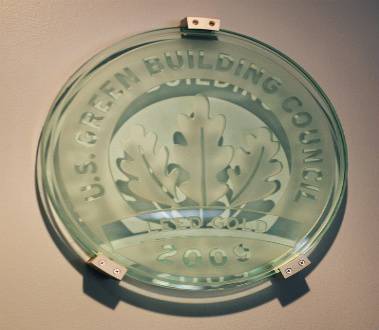 “All of the plywood used is formaldehyde free,” Cooper explained. “The tile you see in the old dining area is from 1965. Instead of throwing that in a landfill, we searched everywhere to find a tile that matched and continued the flooring into the new spaces.”
“All of the plywood used is formaldehyde free,” Cooper explained. “The tile you see in the old dining area is from 1965. Instead of throwing that in a landfill, we searched everywhere to find a tile that matched and continued the flooring into the new spaces.”
The revamped kitchen features an oil recycler. “We use 100 percent non-hydrogenated canola oil. Afterwards, we filter it and the recycled oil is automatically heated so it won’t liquefy,” Cooper said. “Each week it’s pumped through a cylinder, and then collected outside of the building through a hose.”
The new dining hall sits under the glow of natural light for the majority of the day thanks to new skylights. When it starts getting dark, only then do automatic lights come on, adjusting their brightness to adhere to the fading natural light within the room.
“All the pipes you see running across the top of the dining room collect rain water,” Cooper said. “The water is pumped through a cistern and used to fill the public’s toilets.”
Water collected from the pipes serves another purpose — to help grow the many plants within the Hendrick House’s rooftop garden.
“In 2011 we put two plots up there to see if anything would grow,” Cooper explained. “When we saw things were growing we said ‘let’s do this.’”
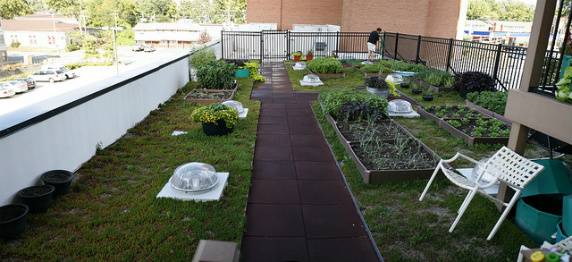
Now, the garden is home to oregano, marjoram, four different kinds of basil, two kinds of mint, chives, fennel, thyme, lemon thyme, rosemary, garlic, cilantro, and tomatoes. If granted a city permit, the garden will extend to a much larger section of roof.
“I’d like to grow some sweet corn if we get the permit,” Hendrick joked. “To be more practical, we’d probably grow a lot more tomatoes and lettuce.”
The Hendrick House uses pounds of salad greens each day. “I would really like to put in something that could support growth year round,” Cooper said in reference to the potential extension.
Dawson went on to state that the Hendrick House has “several little experiments going on” in the effort to bring the freshest food to students.
“We have a plot at Meadowbrook Park, our rooftop garden, this huge expanse of roof, but we also have the ability to get a creative arrangement going to get a bigger plot of land to plant some of our own crops,” Dawson said. “We’re learning a lot and figuring out what makes the most sense economically. We have to determine if we are going to get that much better of a product and save enough money while doing it or if we should buy locally.”
Though the future of the Hendrick House’s farming endeavors are not yet clear, the mission is.
“We continue to look at how we can work with food,” Dawson said. “We want to see where this dinner can go. It may lead to more dinners or some other separate entity. It’s just nice to know we did it, and we did it successfully.”
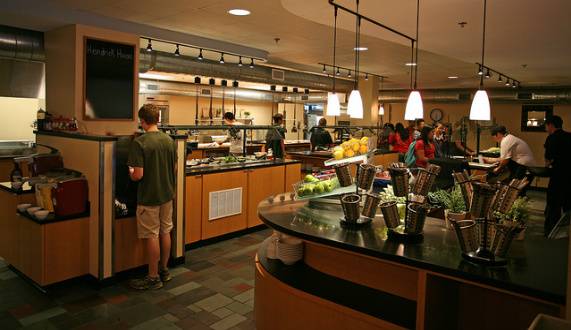
In the meantime, the staff at the Hendrick House will continue providing their personal touch to student housing, food services to Presby Hall, Armory House, and another 30 fraternities and sororities, all while working hand in hand with local growers.
“The exciting thing about the event is that though people look at us and say, ‘Oh they do food service and a residence hall,’ we don’t like to keep ourselves in that box,” Dawson said. “Yes, we do those things, but we always like to push that envelope.”
Prospective residents, or those wishing to learn more about the Hendrick House, can visit their website here.
All photos by Eric Ponder, used with permission.








